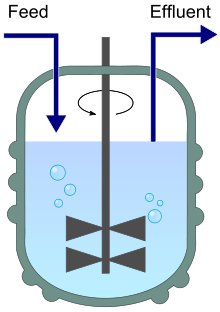Simple Chemostat
Simple Chemostat

Stirred bioreactor operated as a chemostat, with continuous inflow (the feed) and outflow (the effluent). The rate of medium flow is controlled to keep the culture volume constant.
1. Chemostat
A chemostat (from "Chemical environment is static") is a bioreactor to which fresh medium with nutrient (substrate) is continuously added, while culture liquid is continuously removed to keep the culture volume constant. By changing the rate at which medium is added to the bioreactor the growth rate of the culture (microorganism) can be easily controlled [Wiki-Chemostat].
2. Mathematical model
The mathematical model of a simple chemostat is [Chemostat95]:
where:
\(S(t)\) - the substrate concentration [conc.]
\(X(t)\) - the microorganisms concentration [conc.]
\(S_{in}\) - the input substrate concentration [conc.]
\(X_{in}\) - the input microorganisms concentration [conc.]; usually \(X_{in} = 0\)
\(D\) - the dilution (or washout) rate [1/time]
\(\gamma\) - the yield coefficient of microorganisms (\(\gamma \leq 1\)) [-]
\(\mu(S) = \frac{m.S}{K+S}\) - the specific growth rate (Monod type) [conc./time]
\(m\) - the maximum specific growth rate of the microorganisms [1/time]
\(K\) - the half saturation constant [conc.]
and
\(S'=\frac{dS(t)}{dt}\) - the rate of change of the substrate concentration [conc./time]
\(X'=\frac{dX(t)}{dt}\) - the rate of change of the microorganisms concentration [conc./time]
In simple words, the above ordinary differential equations say:
- Units:
[conc.] - unit for concentration; usually is measured in: g/L, kmol/m3 or kgCOD/m3
[time] - unit for time; usually is measured in day
3. References
| [Wiki-Chemostat] | http://en.wikipedia.org/wiki/Chemostat |
| [Chemostat95] | Smith, H. and Waltman, P. The Theory of the Chemostat: Dynamics of Microbial Competition. Cambridge University Press, 1995 |
DDE Chemostat (Example 1)
DDE Chemostat (Example 2)
Chemostat (DDE)

Stirred bioreactor operated as a chemostat, with continuous inflow (the feed) and outflow (the effluent).
1. Delay differential equations (DDE)
Delay differential equations (DDEs) are a type of differential equations in which the derivative of the unknown function at a certain time is given in terms of the values of the function at previous times. The general form of the time-delay differential equation for \(x(t)\) is
where \(x_t=\{x(\tau):\tau\leq t\}\) represents the trajectory of the solution in the past [Wiki-DDE].
2. Mathematical model
Examples of a mathematical model of a chemostat with delay differential equations (DDE) are:
Example 1:
\(s'_{1}(t)=D\left(s_{1}^{in}-s_{1}(t)\right)-k_{1}\mu_{1}\left(s_{1}(t)\right)x_{1}(t)\)
\(x'_{1}(t)=\mu_{1}\left(s_{1}(t-\tau_{1})\right)x_{1}(t-\tau_{1})-\alpha Dx_{1}(t)\)
\(s'_{2}(t)=D\left(s_{2}^{in}-s_{2}(t)\right)+k_{2}\mu_{1}\left(s_{1}(t)\right)x_{1}(t)-k_{3}\mu_{2}\left(s_{2}(t)\right)x_{2}(t)\)
\(x'_{2}(t)=\mu_{2}\left(s_{2}(t-\tau_{2})\right)x_{2}(t-\tau_{2})-\alpha Dx_{2}(t)\)
Example 2:
\(s'_{1}(t)=D\left(s_{1}^{in}-s_{1}(t)\right)-k_{1}\mu_{1}\left(s_{1}(t)\right)x_{1}(t)\)
\(x'_{1}(t)=e^{-\alpha D \tau_{1}}\mu_{1}\left(s_{1}(t-\tau_{1})\right)x_{1}(t-\tau_{1})-\alpha Dx_{1}(t)\)
\(s'_{2}(t)=D\left(s_{2}^{in}-s_{2}(t)\right)+k_{2}\mu_{1}\left(s_{1}(t)\right)x_{1}(t)-k_{3}\mu_{2}\left(s_{2}(t)\right)x_{2}(t)\)
\(x'_{2}(t)=e^{-\alpha D \tau_{2}}\mu_{2}\left(s_{2}(t-\tau_{2})\right)x_{2}(t-\tau_{2})-\alpha Dx_{2}(t)\)
where:
\(s_{1}, s_{2}\) - the substrate concentrations
\(x_{1}, x_{2}\) - the bacteria concentrations
\(s_{1}^{in}, s_{2}^{in}\) - the input substrate concentrations
\(D\) or \(u\) - the dilution (or washout) rate
\(k_{1}, k_{2}, k_{3}\) - the yield coefficients
\(\alpha\) - the proportion of bacteria that are affected by the dilution rate D
\(\tau_{1}, \tau_{2}\) - the time delay in conversion of the corresponding substrate to viable biomass for the i-th bacterial population
\(\mu_{1}(s_{1}) = \frac{m_{1}s_{1}}{k_{s1}+s_{1}}\) - the specific growth rate of the bacteria-1
\(\mu_{2}(s_{2}) = \frac{m_{2}s_{2}}{k_{s2}+s_{2}+(s_{2}/k_{I})^{2}}\) - the specific growth rate of the bacteria-2
\(m_{1}, m_{2}\) - the maximum specific growth rates of the bacteria
\(k_{s1}, k_{s2}\) - the half saturation constants
\(k_{I}\) - constant
